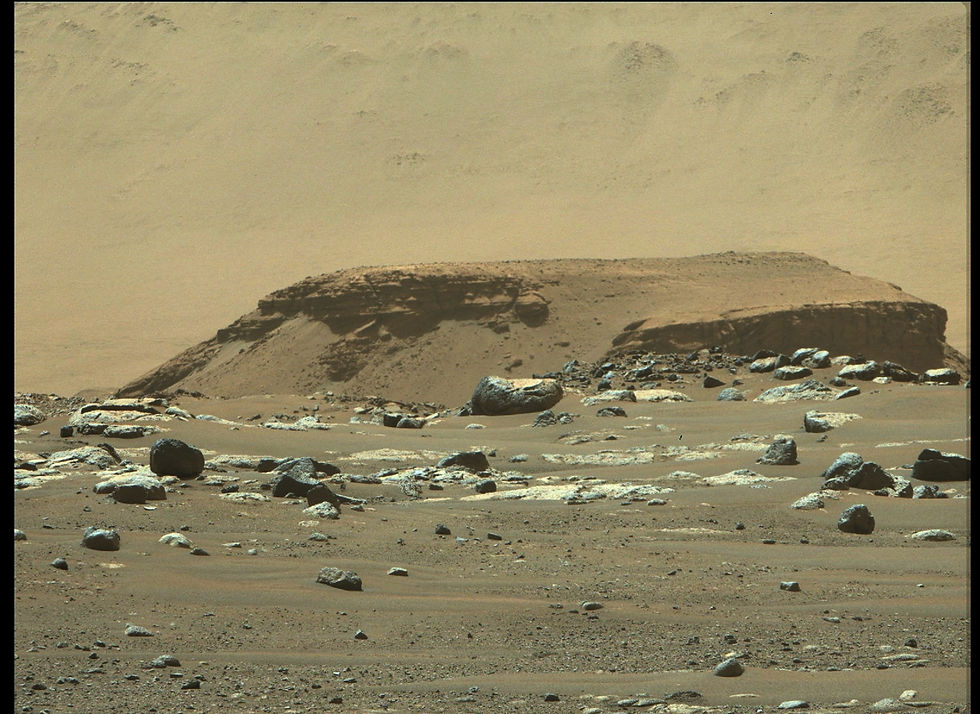For more than a year, Dr. Anastasia Yanchilina, a Research Scientist at Impossible Sensing with expertise in prehistoric climate change & oceanography, marine geology, and geophysics (specifically in diagenesis of silicate rocks) has been conducting operations of the Perseverance rover as a member of NASA’s Mars 2020 Science Team. Her job, in a sense, is to joystick NASA’s rover around the red planet from her laptop here on Earth.

Dr. Anastasia Yanchilina | Photo by Sam Owens
“It’s been a dream come true,” says Dr. Yanchilina, “to be a part of the Mars 2020 / Perseverance Science Team and contribute to one of humankind's most ambitious off-planet experiments. It's thrilling to wake up to new discoveries –– beamed from Mars to my computer –– nearly every morning.”
On Feb 18, 2021, NASA’s Perseverance rover landed in Mars' Jezero Crater with main objectives to seek signs of ancient life and collect samples of rock and regolith (broken rock and soil) for possible return to Earth. Perseverance carries with it a number of cameras, instruments, and even a helicopter (Ingenuity) to document its journey. These tools are able to capture and send back visualizations of the rover traversing terrain and exploring local geology. They also make in-situ scientific observations in the rover's search for signs of past life.

Perseverance Selfie Image Taken on sol 46
The landing site, given the name Octavia E. Butler in honor of the late science fiction author, lies a few kilometers east of a delta feature that previously belonged to inlet river channels. It is believed that the river channels delivered water into the Jezero Crater lake about 3.6-3.8 billion years ago. This site was chosen for its high potential preservation of biosignatures such as olivine-carbonates, previously discovered through orbital data, that have the potential to retain information about the existence of life in the distant past when water freely flowed on the planet.

Perseverance began its journey a few kilometers east of the delta remains and, since landing (and at the time this article was written), has traversed 8 kilometers of terrain across a series of geological units identified in Jezero Crater. It initially headed south and then northeast to observe, in-situ, two key geologic units belonging to the crater floor before navigating towards the delta. It has collected 8 core samples to bring back to Earth.
Impossible Sensing specializes in developing innovations that are important for a wide variety of applications, including the kind of remote sampling and in-situ analysis of chemical species being performed by certain instruments onboard Perseverance. Dr. Yanchilina focuses on the findings from two of these instruments: SHERLOC and WATSON. SHERLOC is a Raman spectrometer mounted on the rover's robotic arm and uses a laser to characterize mineralogy or any organics present. WATSON is a high-resolution imaging camera that pairs chemistry measurements with a visualization of what they look like within the rock or soil.
Dr. Yanchilina and fellow members of the Mars 2020 Science Team pair observations from SHERLOC and WATSON with data from other Perseverance instruments like Mastcam-Z, SuperCam, and PIXL to interpret the geochemistry and mineralogy encountered by the rover. Then, they collectively decide where to direct Perseverance, what observations it will make next, and what samples it will take & cache for future return to Earth and continued scientific analyses.

Delta Remnant | Courtesy of NASA
Key findings have been published HERE (via science.org), where it is shown that billions of years ago – when Mars had an atmosphere thick enough to support flowing water across its surface – Jezero’s fan-shaped delta experienced late-stage flooding. This resulted in rocks and debris being carried from the highlands into the Crater. The Science Team estimates that a torrent of water was needed to transport the boulders (some for tens of miles) and would have had to travel at speeds ranging from 4 to 20 mph.
Check back for more updates!
Further Reading
Perseverance Rover's Descent and Touchdown on Mars (Official NASA Video) https://www.youtube.com/watch?v=4czjS9h4Fpg
Ken Farley, project scientist for the mission, description of one of the geologic features of interest, delta remnant. A geologic outcrop related to the main delta but separated by post delta deposition environmental activity (e.g., erosion, etc). https://www.youtube.com/watch?v=yOplTCgnJFQ&t=7s
Comentarios